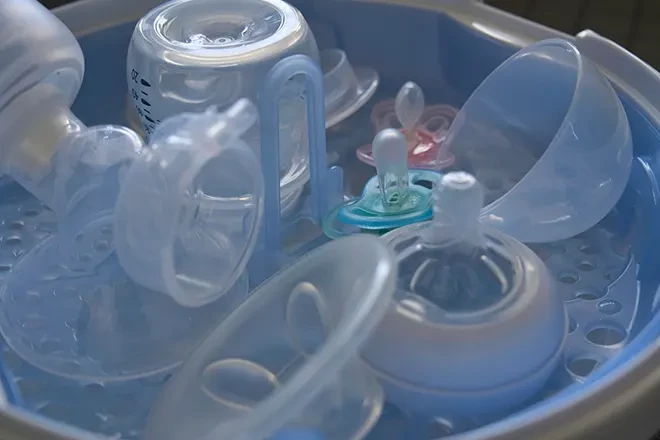Sterilizing your baby’s bottles is a way of keeping them extra clean. While washing bottles in hot water and soap will get rid of germs, sterilizing takes it further, using high temperatures to help remove potentially harmful contaminants and bacteria. Sterilizing bottles can add another layer of protection for your baby’s developing immune system.
Let’s explore the three primary manual methods for sterilizing baby bottles: boiling water, bleach, and steam. These work with most plastic, glass, silicone, and stainless steel bottles.
How to sterilize baby bottles with boiling water
The boiling method is a simple and traditional bottle sterilization technique that requires just a pot and a stove. Here’s how to do it:
- Wash the bottles, nipples, and rings with warm soapy water.
- Place everything in a pot of boiling water for at least five minutes.
- Use clean tongs to remove the bottles, nipples, and rings and let them air dry on a clean towel.
How to sterilize baby bottles with steam
Steam is generally the most dependable way to kill pathogens that could harm your baby. You can steam-sterilize baby bottles using an electric steam sterilizer before trying out the following:
- Wash the bottles, nipples, and rings with warm soapy water.
- Place everything in the steam sterilizer, leaving plenty of room between each component.

Steam is generally the most dependable way to kill pathogens that could harm your baby.
How to sterilize baby bottles with bleach
When diluted, bleach is an effective bottle sterilizer. Be sure to use this method in a well-ventilated area and keep bleach out of reach of children. Wear gloves to protect sensitive skin while taking these steps:
- Mix a solution of one teaspoon of unscented bleach per quart of water. It's important to use unscented bleach, as scented bleach may contain additional chemicals that can be harmful to your baby.
- Wash the bottles, nipples, and rings with warm soapy water.
- Fully submerge the bottles, nipples, and rings in the bleach solution. Make sure the solution completely covers all parts.
- Let them soak for at least two minutes.
- After everything has soaked for two minutes, remove them from the bleach solution and rinse them thoroughly with clean water to ensure no bleach residue is left.
- Let the bottles, nipples, and rings air dry on a clean towel or drying rack.
- If you notice any discoloration or a strong bleach odor after sterilizing with bleach, rewash the bottles with warm soapy water and rinse them thoroughly before use.
Should you buy a bottle sterilizer?
Many parents find an electric bottle sterilizer one of the most convenient ways to sterilize baby bottles. Depending on the model, you may be able to sterilize several bottles simultaneously as well as other small items such as pacifiers, teethers, and breast pump parts.
Bottle sterilizers, especially smaller models, are also handy for travel. If you choose to buy a bottle sterilizer, be sure to follow the manufacturer's instructions.
How often do you sterilize baby bottles?
It's best to clean your bottle after every use and sterilize it at least once daily, especially during the baby's first year when their immune system is still developing. You should sterilize the bottles more frequently if your baby has been exposed to illness or if the bottles have been sitting unused for an extended period of time.
Explore Enfamil Family Beginnings® for more newborn tips and support
Bottle sterilization combined with regular, thorough bottle cleaning will give you additional peace of mind while your little one's immune system strengthens and develops. For more tips and resources on all things baby, be sure to join Enfamil Family Beginnings®. Enjoy up to $400 in savings, plus exclusive rewards, support, and surprises.
